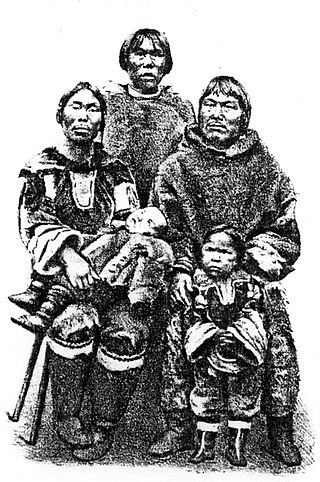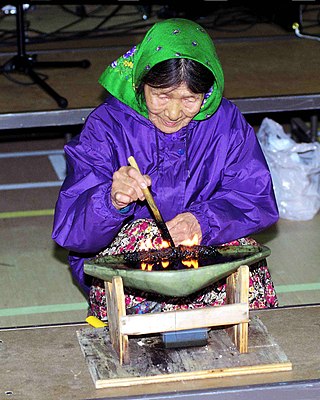
Nanook of the North is a 1922 American silent film that combines elements of documentary and docudrama/docufiction, at a time when the concept of separating films into documentary and drama did not yet exist. In the tradition of what would later be called salvage ethnography, the film follows the struggles of the Inuk man named Nanook and his family in the Canadian Arctic. It is written and directed by Robert J. Flaherty, who also served as cinematographer, editor, and producer.

William Nicholas Selig was a vaudeville performer and pioneer of the American motion picture industry. His stage billing as Colonel Selig would be used for the rest of his career, even as he moved into film production.

The Selig Polyscope Company was an American motion picture company that was founded in 1896 by William Selig in Chicago, Illinois. The company produced hundreds of early, widely distributed commercial moving pictures, including the first films starring Tom Mix, Harold Lloyd, Colleen Moore, and Roscoe "Fatty" Arbuckle. Selig Polyscope also established Southern California's first permanent movie studio, in the historic Edendale district of Los Angeles.

Abraham Ulrikab was an Inuk from Hebron, Labrador, in the present-day province of Newfoundland and Labrador, Canada, who – along with his family and four other Inuit – agreed to become the latest attraction in the ethnographical shows organized by Carl Hagenbeck, owner of the Tierpark Hagenbeck, a zoo in Hamburg, Germany.

Ray Mala was a prominent Alaska Native actor. He was one of Hollywood's Native American movie actors along with Lillian St. Cyr, Jesse Cornplanter, Chief Yowlachie, William Eagle Shirt, and Will Rogers who also had successful careers during that time. Mala's career peaked in the 1930s and he was best known for his lead role in Republic Pictures' 14-part serial Robinson Crusoe of Clipper Island (1936) following his feature role in MGM's Eskimo, directed by Woody Van Dyke. He was named a "Top Ten Alaskan" by TIME Magazine in 2009.

Inuit art, also known as Eskimo art, refers to artwork produced by Inuit, that is, the people of the Arctic previously known as Eskimos, a term that is now often considered offensive. Historically, their preferred medium was walrus ivory, but since the establishment of southern markets for Inuit art in 1945, prints and figurative works carved in relatively soft stone such as soapstone, serpentinite, or argillite have also become popular.

The Trail of Hate is a 1917 American silent drama film that portrayed the military exploits and personal rivalries of two United States Army officers stationed in the American West and later in the Philippines. The production starred John Ford, who at that time was credited as "Jack Ford". Currently classified as a lost film, this two-reel short is identified by some biographers of John Ford and in many filmographies, both in print and online, to be his second release as a director. He is also credited in various sources for writing the film's screenplay or "scenario". Other Ford biographers, however, most notably American director and film historian Peter Bogdanovich, credit this production's screenplay and its direction to John's older brother Francis Ford.

The Immortal Alamo is an American silent film released on May 25, 1911. The Immortal Alamo is the earliest film version of the events surrounding the 1836 Battle of the Alamo. The film was directed by William F. Haddock and produced by Gaston Méliès. The film's cast included Francis Ford, Edith Storey, William A. Carroll, and one hundred cadets from the Peacock Military Academy. The film was said to be 10 minutes in length and focused on the formula of "pretty girl, shy hero, and a villain" during the battle.

Inuit are a group of culturally and historically similar Indigenous peoples traditionally inhabiting the Arctic and Subarctic regions of North America, including Greenland, Labrador, Quebec, Nunavut, the Northwest Territories, Yukon (traditionally), Alaska, and Chukotsky District of Chukotka Autonomous Okrug, Russia. Inuit languages are part of the Eskimo–Aleut languages, also known as Inuit-Yupik-Unangan, and also as Eskaleut. Inuit Sign Language is a critically endangered language isolate used in Nunavut.

The Inuit are an indigenous people of the Arctic and subarctic regions of North America. The ancestors of the present-day Inuit are culturally related to Iñupiat, and Yupik, and the Aleut who live in the Aleutian Islands of Siberia and Alaska. The term culture of the Inuit, therefore, refers primarily to these areas; however, parallels to other Eskimo groups can also be drawn.

Uvavnuk was an Inuk woman born in the 19th century, now considered an oral poet. The story of how she became an angakkuq, and the song that came to her, were collected by European explorers of Arctic Canada in the early 1920s. Her shamanistic poem-song, best known as "Earth and the Great Weather", has been anthologised many times.
Hugh Brody is a British anthropologist, writer, director and lecturer.

The Carpet from Bagdad is a 1915 American silent adventure film directed by Colin Campbell and based on Harold MacGrath's 1911 eponymous novel. In the story, Horace Wadsworth, one of a gang of criminals planning a bank robbery in New York, steals the titular prayer rug from its Baghdad mosque. He sells the carpet to antique dealer George Jones to fund the robbery scheme. But the theft places both men and Fortune Chedsoye, the innocent daughter of another conspirator, in danger from the carpet's guardian.

Ulayu Pingwartok was a Canadian Inuk artist known for drawings of domestic scenes and nature.

Louella Maxam was an American actress who performed in over 50 silent films from 1913 until 1921. She was often cast in comedies and Westerns, most notably being identified in 1915 as a "leading lady" in a series of shorts starring Tom Mix, who during the silent and early sound eras was promoted as the "Cowboy King of Hollywood". Later, she was a female lead in other films for various studios, including several productions featuring another early cowboy star, Franklyn Farnum. Following her departure from acting, Maxam worked in county and municipal government in California, including service with the Burbank police department, where in 1943 she was hired as that city's first "police woman".

The Ringtailed Rhinoceros is a lost 1915 American silent comedy-drama film that depicted the ruinous effects of alcohol on a good-natured man and on the lives of the people around him. Like snakes and "pink elephants" that have been used in many societies to symbolize heavy drinking or been associated with the hallucinations of drunkards, the main character in this "'photophantasy'" blamed instead a "Ringtailed Rhinoceros" for his excessive use of wine and liquor.

Lost in the Arctic is a lost 1911 American silent drama film that portrayed the Inuit or "Eskimo" culture in the northern coastal area of Labrador. Directed by William V. Mong and produced by the Selig Polyscope Company, the "one-reeler" costarred Columbia Eneutseak, J. C. Smith, and also Mong. The film was not, as advertised by Selig and in trade publications in 1911, shot in the Arctic or even farther south in Labrador. It and another Selig release, The Way of the Eskimo, were produced at the same time in the same location in the United States, in Escanaba, Michigan. Both "Arctic" stories were filmed there in less than two weeks during the early winter months of 1911, staged along the frozen shoreline of Little Bay de Noc that connects to Lake Michigan.

Columbia Eneutseak, also billed as Nancy Columbia, was an American performer in silent films, known for writing and starring in The Way of the Eskimo (1911).

Esther Eneutseak (1877–1961) was an Inuk performer and actor. Originally from Nain, Labrador, she performed at "Inuit villages" at world's fairs and circuses, and in films with her daughter, Columbia Eneutseak. Her self-chosen surname means "good person".





















